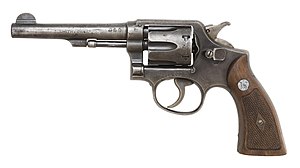Smith & Wesson Victory Model
| Smith & Wesson Model 1899 Military & Police | |
|---|---|

Lend-Lease M&P dating from World War II, missing lanyard ring
|
|
| Type | Service revolver |
| Place of origin | United States |
| Service history | |
| Used by | See Users |
| Wars |
World War I Easter Rising Irish War of Independence World War II Korean War Vietnam War Gulf War other conflicts |
| Production history | |
| Designed | 1899 |
| Manufacturer | Smith & Wesson |
| Produced | 1899–present |
| Variants | 38 M&P M&P Model 1902 Model of 1905 Victory Model Model 10 |
| Specifications | |
| Weight | ~ 34 oz (907 g) with standard 4" (102 mm) barrel (unloaded) |
| Barrel length |
|
|
|
|
| Cartridge |
.38 Long Colt .38 Special .38/200 (.38 S&W) |
| Action | Double action |
| Muzzle velocity | 1,000 feet per second (300 m/s) (.38 Special) 685 feet per second (209 m/s) (.38/200) |
| Feed system | 6-round cylinder |
| Sights | Blade front sight, notched rear sight |
The Smith & Wesson Model 10, previously known as the Smith & Wesson .38 Hand Ejector Model of 1899, the Smith & Wesson Military & Police or the Smith & Wesson Victory Model, is a revolver of worldwide popularity. It was the successor to the Smith & Wesson .32 Hand Ejector Model of 1896 and was the first Smith & Wesson revolver to feature a cylinder release latch on the left side of the frame like the Colt M1889. In production since 1899, it is a six-shot double-action revolver with fixed sights. Over its long production run it has been available with barrel lengths of 2 in (51 mm), 3 in (76 mm), 4 in (100 mm), 5 in (130 mm), and 6 in (150 mm). Barrels of 2.5 inches (64 mm) are also known to have been made for special contracts. Some 6,000,000 of the type have been produced over the years, making it the most popular centerfire revolver of the 20th century.
In 1899, the United States Army and Navy placed orders with Smith & Wesson for two to three thousand Model 1899 Hand Ejector revolvers chambered for the M1892 .38 Long Colt U.S. Service Cartridge. With this order, the Hand Ejector Model became known as the .38 Military and Police model. That same year, in response to reports from military sources serving in the Philippines on the relative ineffectiveness of the new cartridge, Smith & Wesson began offering the Military & Police in a new chambering, .38 S&W Special (a.k.a. .38 Special), a slightly elongated version of the .38 Long Colt cartridge with greater bullet weight (158 grains) and powder charge increased from 18 to 21 grains of gunpowder.
In 1902 the .38 Military & Police (2nd Model) was introduced, featuring substantial changes. These included major modification and simplification of the internal lockwork and the addition of a locking underlug on the barrel to engage the previously free-standing ejector rod. Barrel lengths were 4, 5, 6, and 6.5 inches with a rounded butt. Serial numbers for the Military & Police ranged from number 1 in the series to 20,975. Most of the early M&P revolvers chambered in .38 Special appear to have been sold to the civilian market. By 1904, S&W was offering the .38 M&P with a rounded or square butt, and 4-, 5-, and 6.5-inch barrels.
The .38 S&W Military & Police Model of 1905 4th Change, introduced 1915, incorporated a passive hammer block and enlarged service sights that quickly became a standard across the service revolver segment of the industry. Heat treating of cylinders began in 1919.
...
Wikipedia
